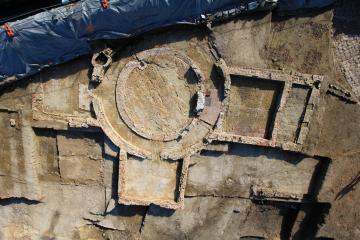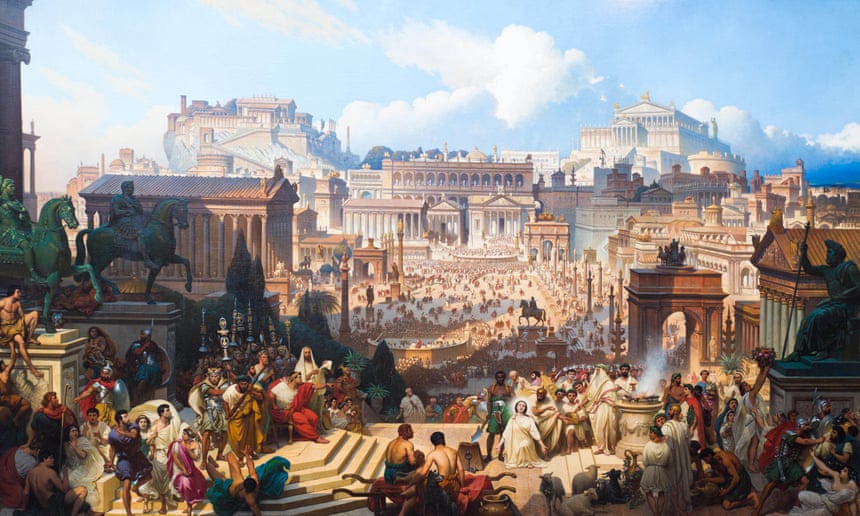The Roman Archaeology Blog is concerned with news reports featuring Roman period archaeology. If you wish to see news reports for general European archaeology, please go to The Archaeology of Europe Weblog.
Sunday, March 20, 2016
Italian town 'forgets' Roman theatre found under ex-factory
An ancient Roman amphitheatre, in the town of Fano, in the Marche region, is slowly rotting away beneath an abandoned factory from the early 1900s.
“The original builders most probably knew what they were building on, but they were different times,” Fano engineer Salvatore Vittorio Russo told Corriere della Sera.
Today, laws prohibit sites of archaeological interest from being developed, something the building's owners – a consortium of local businessmen - discovered to their chargin.
Fifteen years ago they gained permission to turn the uncovered 1,830 square-metre ex-factory into 22 apartments.
“Before the project could get underway the council asked to perform a geophysical scan and found the remains of the theatre under the factory floor,” Russo explained.
Read the rest of this article...
Archéologie à Lille : aux origines du quartier de Fives
La fouille révèle une occupation du site du Ier siècle avant notre ère au XVIIIe siècle. L’époque moderne est marquée par la présence successive d’un château défensif puis résidentiel. Couplées à des recherches en archives, ces découvertes contribuent à une meilleure connaissance des abords de Lille et la vie quotidienne de ses habitants.
Read the rest of this article...
Tuesday, March 15, 2016
The Ides of March: The assassination of Julius Caesar and how it changed the world
Caesar's death paved the way for the Roman empire after a bloody cycle of civil wars, and secured him the hallowed immortality he always craved
Spurinna was a haruspex. His calling was vital, if a little unusual, requiring him to see the future in the warm entrails of sacrificial animals.
At the great festival of Lupercalia on the 15th of February 44 B.C., he was a worried man. While priests were running around the Palatine Hill hitting women with thongs to make them fertile, Spurinna was chewing over a terrible omen.
Read the rest of this article...Story of cities #2: Rome wasn't planned in a day … in fact it wasn't planned at all
An 18th-century painting of The Martyr of Saint Agnes in the Roman Forum, with the hills behind. Photograph: Active Museum/Alamy Stock Photo
The grid system which the Roman republic exported all over Europe was never employed in the capital itself. The city has always lacked a coherent plan – save for the monumental temple that once towered over it
According to Tacitus, perhaps the greatest of all Roman historians, it was the great temple of Jupiter Optimus Maximus on the Capitoline Hill that held the key to the future of ancient Rome.
Writing about a fire at the temple in AD69, Tacitus assumed the conflagration would embolden the enemy Gauls into thinking they might finally conquer the city, such was the symbolism of the temple. “This fatal conflagration has given proof from heaven of the divine wrath,” he wrote, “and presages the passage of sovereignty of the world to the peoples beyond the Alps.”
Read the rest of this article...
Sunday, March 6, 2016
Cologne celebrates its ancient Roman heritage
Jesus was a toddler gingerly taking his first steps into the wider world when the Romans built the walls of their fortress in Cologne. 2,010 years later it’s still standing, and has just been given a makeover.
Not only is the six-meter-high wall the oldest stone structure in Germany, it’s the oldest north of the Alps, Markus Trier, director of the Roman-German Museum boasted on Friday.
While the people of the Orkney Islands in Scotland - where the stone walls of Skara Brae date back to 3,100 BC - might have something to say about that claim, the reopening of the wall will provide a welcome boost to Cologne’s tourism after a series of negative headlines for the city in recent months.
Read the rest of this article...
Ancient Roman Puzzle Gets New Piece
This is the latest addition to an ancient Roman map puzzle.
A fragment of the world’s oldest and largest
unsolved jigsaw puzzle, a 2,200-year-old map of Rome made of thousands
of marble fragments, has been finally reunited to the other existing
pieces, according to the Rome Cultural Heritage Superintendency.
The map, known as Forma Urbis Romae, was carved into marble slabs between 203 and 211 A.D., during the rule of the emperor Septimius Severus.
Read the rest of this article...
Ancient Roman sites face rat emergency
A ticket desk for the Roman Forum and the Palatine Hill was closed on Wednesday due to a reported rat emergency that has hit the area and the Palazzo Massimo museum near Rome's central Termini station, Archaeology Superintendent Francesco Prosperetti said.
Ancient Roman sites face rat emergency Roman Forum ticket desk closed by drips of rodent blood [Credit: TANN]
Prosperetti said it was a "big problem" that the superintendency "cannot address" on its own. "A rat got trapped in a gap on the roof and the staff member who was working there saw blood drip on the desk," Prosperetti said when asked why part of a new ticket office was closed despite long queues.
Read the rest of this article...
Einzigartiges römisches Priesterinnengrab
Archäologische Landesausstellung im LVR-LandesMuseum Bonn zeigt spektakuläre Ausgrabungen der letzten fünf Jahre in NRW
Read the rest of this article...
Thursday, March 3, 2016
Catacombs of Marcellinus and Peter restored
The culmination of a one year project to restore the paleochristian frescoes that decorate the Roman catacombs of Sts. Marcellinus and Peter "ad duas lauros", was announced by the Vatican this week.
The restored frescoes of the catacombs of Marcellinus and Peter
[Credit: Alexey Gotovskiy/CNA]
This initiative was the result of an agreement signed in June 2012 between the Pontifical Commission of Sacred Archaeology of the Vatican and the Heydar Aliyev Foundation (HAF) of Azerbaijan, which funded the project.
Among the restored frescoes are those of the cubicle of Susanna and the fossor, the niche of Daniel, the arcosolium of Orpheus, the cubicle of Our Lady with two Magi, and the cubicle of the praying matron.
Read the rest of this article...
Wednesday, March 2, 2016
More Pompeii houses to open to public from spring
More buildings than ever will be accessible to visitors to Pompeii from the spring, the site's officials said on Thursday.
More
Pompeii houses to open to public from spring A fresco of Venus in the
House of Venus in the Shell [Credit: Carole Raddato/Flickr]
The extra sites include the house of Julia Felix, an extravagant ancient spa, the Little House of the Orchard, which is home to colourful frescoes, and the gardens of the House of Venus in the Shell. Tourists will also be able to see some human casts, shown for the first time, and an exhibition of Egyptian art and statues, called 'Egypt Pompeii', from mid-April. New routes around the site will also be opened, allowing access to these new areas and also ensuring that the usual routes do not get worn out by the three million visitors who come to Pompeii each year.
Read the rest of this article...
Subscribe to:
Posts (Atom)









